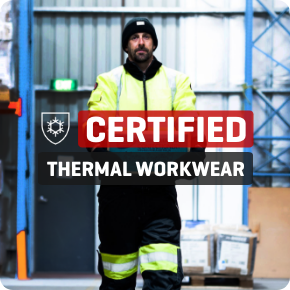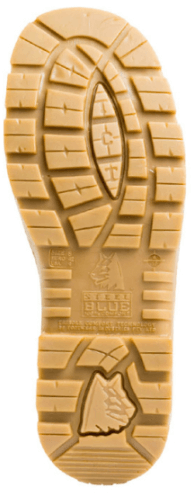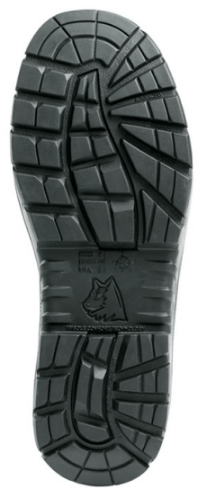Which boot outsole should you choose? TPU, Nitrile or Rubber?

The outsole of a boot is something that may be overlooked when you buy a new pair of boots, but you should know what material is used in this part of the boot to ensure it suits your job role. If technical terms such as ‘TPU’ and ‘Nitrile’ make your eye glaze over, this article will shed some light on the basics of each boot outsole material, their benefits and draw-backs and their ideal applications.
An outsole that suits your job role properly will last longer and keep you more comfortable!
Thermoplastic Urethane (TPU) Boot Outsoles
TPU is considered the ‘all-rounder’ of outsoles and the most commonly used amongst brands such as Steel Blue, KingGee and JB’s Wear. It is an advanced form of polyurethane (PU) that is very study, abrasion resistant and flexible. Most boots come standard with TPU soles these days and its wise to not settle for anything less durable, such as PU.
Benefits of TPU:
- Lightweight
- Resistance to temperatures up to 130°C (266°F)
- Highly resistant to most oils and chemicals
- High tolerance to abrasion, cracking, splitting and cuts/tears
- Premium slip resistance for uneven and slippery surfaces (many are SRC rated. Read more on slip resistance here)
- Cold resistant down to -20°C, stays flexible in low temperatures
Negatives of TPU:
- Not highly resistant to heat (max. of 130°C)
- Can increase the price of the boot, compared to cheaper materials such as PU
- Less storage longevity, so ensure the boots you buy haven’t been sitting on the shelf for years!
Ideal Applications for TPU outsoles: Indoors and outdoors, slippery or uneven surfaces, environments where temperatures aren’t extreme
Nitrile Boot Outsoles
The main benefit of Nitrile over other soles is its extreme resistance to heat, up to 300°C (572°F). This makes them ideal for people working in hot conditions (mining, asphalt or steel plates) or working around hot objects (engineering, welding, grinding etc). At these temperatures, there’s a 60-second threshold before it reaches melting point. Specialised boots such as the Mack TerraPro boast these advanced features, thanks to their Nitrile outsoles.
Benefits of Nitrile Outsoles:
- Premium resistance to oil, mild acids, alkalis’, animal fats, chemicals etc.
- Superior resistance to abrasion, splitting and cracking
- Helps reduce excess static electricity
- Extreme heat tolerance, up to 300°C
- Premium cut resistance and tear strength
- Premium slip resistant capability that improves with wear
- Superior puncture resistance
Negatives of Nitrile Outsoles:
- Not quite as flexible and strong as TPU
- Can be pricy
- Is less commonly used than TPU, so it may be more difficult to find Nitrile soled boots you like
Ideal Applications of Nitrite Outsoles: Indoors and outdoors, slippery or uneven surfaces, especially where chemicals/oils etc. are present, environments with extreme temperatures
Rubber Boot Outsoles
Rubber outsoles are also common. It is sometimes confusing classifying something as ‘rubber’, considering Nitrile and TPU are forms of rubber anyway! However, rubber outsoles are generally made up of vulcanised caoutchouc, which is a type of latex. Puma boots have rubber soles and the benefits outlined below.
Benefits of Rubber Outsoles:
- Exceptionally sturdy, due to the process used to make them
- Extreme heat tolerance, up to 300°C
- Superior storage longevity
- Premium slip resistance for uneven and slippery surfaces
- Superior puncture resistance
- Superior water resistance, making them easy to clean
- Cold resistant down to -30°C
Negatives of Rubber Outsoles:
- Less flexible when submitted to cold temperatures
- Heavier than alternatives such as TPU and Nitrile
Summary Table
| Advantages | Disadvantages | |
| TPU | Lightweight Resistance up to 130°C (266°F) Premium slip resistance Cold resistant down to -20°C | Not highly resistant to heat Can increase the price of the boot |
| Nitrile | Premium resistance to oil Extreme heat tolerance, up to 300°C Premium slip resistantce Superior puncture resistance | Not quite as flexible and strong as TPU Can be pricy Is less commonly used |
| Rubber | Exceptionally sturdy Extreme heat tolerance, up to 300°C Superior water resistance | Less flexible when submitted to cold temperatures Heavier than alternatives such as TPU and Nitrile |









8 Comments. Leave new
best work boots for delivery drivers
https://shoesknowledge.com/best-work-boots-for-delivery-drivers/
How Much Does It Cost To Resole Work Boots
https://thelovelyfeet.com/how-much-does-it-cost-to-resole-work-boots/